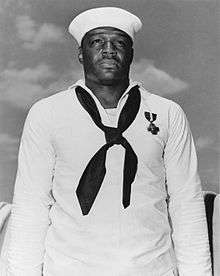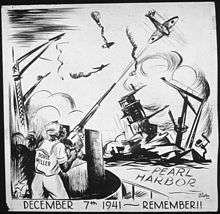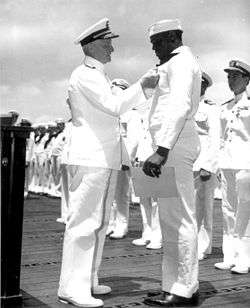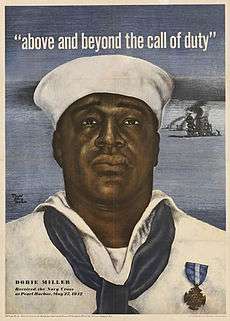Doris Miller
| Doris Miller | |
|---|---|
 Miller with his Navy Cross | |
| Nickname(s) | "Dorie" |
| Born |
October 12, 1919 Waco, Texas, U.S. |
| Died |
November 24, 1943 (aged 24) Gilbert Islands, Gilbert and Ellice Islands † |
| Allegiance |
|
| Service/branch |
|
| Years of service | 1939–1943 |
| Rank | Petty Officer, Ship′s Cook Third Class |
| Unit |
USS West Virginia USS Liscome Bay |
| Battles/wars | |
| Awards |
|
Doris "Dorie" Miller (October 12, 1919 – November 24, 1943) was a Messman Third Class that the United States Navy noted for his bravery during the attack on Pearl Harbor on December 7, 1941. He was the first African American to be awarded the Navy Cross, the third highest honor awarded by the U.S. Navy at the time, after the Medal of Honor and the Navy Distinguished Service Medal. The Navy Cross now precedes the Navy Distinguished Service Medal.[2] Miller's acts were heavily publicized in the black press, making him the iconic emblem of the war for blacks and was their "Number One Hero" and so energized black support for the war effort against a colored Japanese enemy.[3] Nearly two years after Pearl Harbor, he was killed in action when USS Liscome Bay was sunk by a Japanese submarine during the Battle of Makin.
Early life and education
Miller was born in Waco, Texas, on October 12, 1919, to Connery and Henrietta Miller. He was the third of four sons and helped around the house, cooking meals and doing laundry, as well as working on the family farm. Miller was a good student and was a fullback on the football team at Waco′s A.J. Moore High School. On January 25, 1937, at age 17, he began attending the eighth grade again. Forced to repeat the grade the following year, Miller decided to drop out of school.[4] He filled his time squirrel hunting with a .22 rifle and completed a correspondence course in taxidermy. Miller applied to join the Civilian Conservation Corps, but was not accepted. At that time he was 6 feet 3 inches (1.91 m) tall and weighed more than 200 pounds (91 kg).[4]
Miller worked on his father′s farm until shortly before his 20th birthday. On September 16, 1939, he enlisted in the United States Navy, where he became a Mess Attendant, Third Class, one of the few ratings then open to African Americans.[5] Following training at the Naval Training Station, Norfolk, Virginia, he was assigned to the ammunition ship Pyro, but on January 2, 1940, was transferred to the battleship West Virginia, where he became the main cook. In July, he was on temporary duty on the Nevada at the Secondary Battery Gunnery School. He returned to his ship in August [2][5] and was promoted to Ship's Cook, Third Class.[2]
Miller's nickname "Dorie" apparently originated in a typographical error. After he was nominated for recognition for his actions on December 7, 1941, the Pittsburgh Courier released a story on March 14, 1942, that gave his name as "Dorie Miller." Since then some writers have suggested it was a "nickname to shipmates and friends."[4]
Career
Attack on Pearl Harbor

On December 7, 1941, Miller awoke at 0600. After serving breakfast mess, he was collecting laundry when at 0757 Lieutenant Commander Shigeharu Murata from the Japanese carrier Akagi[4] launched the first of nine torpedoes that would hit the West Virginia. When the "Battle Stations" alarm went off, Miller headed for his battle station, an anti-aircraft battery magazine amidship, only to discover that a torpedo had destroyed it.
He went then to Times Square, a central spot where the fore to aft and port to starboard passageways crossed, and reported himself available for other duty.[4] Lieutenant Commander Doir C. Johnson, the ship's communications officer, spotted Miller and saw the potential of his powerful build, and ordered him to accompany him to the bridge to assist with moving the ship's captain, Mervyn Bennion, who had a gaping wound in his abdomen, where he had apparently been hit by shrapnel. Miller and another sailor lifted the skipper and, unable to remove him from the bridge, carried him from his exposed position on the damaged bridge to a sheltered spot behind the conning tower.[6] The captain refused to leave his post, questioned his officers about the condition of the ship, and gave orders.
Lieutenant Frederic H. White ordered Miller to help him and Ensign Victor Delano load the unmanned #1 and #2 Browning .50 caliber anti-aircraft machine guns aft of the conning tower.[7] Miller was not familiar with the machine gun, but White and Delano told him what to do. Miller had served both men as a room steward and knew them well. Delano expected Miller to feed ammunition to one gun, but his attention was diverted, and when he looked again, Miller was firing one of the guns. White had loaded ammunition into both guns and assigned Miller the starboard gun.[4]
Miller fired the gun until he ran out of ammunition, when he was ordered by Lieutenant Claude V. Ricketts, along with Lieutenant White and Chief Signalman A.A. Siewart, to help carry the captain up to the navigation bridge out of the thick oily smoke generated by the many fires on and around the ship. Bennion was only partially conscious at this point, and died soon afterward. Japanese aircraft eventually dropped two armor-piercing bombs through the deck of the battleship and launched five 18 in (460 mm) aircraft torpedoes into her port side. When the attack finally lessened, Miller helped move injured sailors through oil and water to the quarterdeck, thereby "unquestionably saving the lives of a number of people who might otherwise have been lost."[8]
The ship was heavily damaged by bombs, torpedoes and resulting explosions and fires, but the crew prevented her from capsizing by counter-flooding a number of compartments. Instead, the West Virginia sank to the harbor bottom as her surviving crew, including Miller, abandoned ship.[2]
Commendation

On December 15, Miller was transferred to the Indianapolis. On January 1, 1942, the Navy released a list of commendations for actions on December 7. Among them was a single commendation for an unnamed Negro. The National Association for the Advancement of Colored People asked President Franklin D. Roosevelt to award the Distinguished Service Cross to the unknown Negro sailor. The Navy Board of Awards in Washington D. C. received a recommendation that the sailor be considered for recognition. On March 12, 1942, Dr. Lawrence D. Reddick announced, after corresponding with the Navy, that the name of the unknown Negro sailor was "Doris Miller." The next day, Senator James M. Mead (D-NY) introduced a Senate Bill [Senate Reso S.2392] to award Miller the Medal of Honor, but he did not yet know the basis for Miller's deeds. Four days later, Representative John D. Dingell, Sr. (D-MI) introduced a matching bill [H.R.6800]. On March 21, The African-American newspaper Pittsburgh Courier initiated a write-in campaign to send Miller to the Naval Academy.
Miller was recognized as one of the "first US heroes of World War II." He was commended in a letter signed by Secretary of the Navy Frank Knox on April 1, and the next day, CBS radio broadcast an episode of the series "They Live Forever," which dramatized Miller's actions.[4]
Negro organizations began a campaign to give Miller additional recognition. The All-Southern Negro Youth Conference launched a signature campaign on April 17–19. On May 10, the National Negro Congress denounced Knox's recommendation against awarding Miller the Medal of Honor. On May 11, President Franklin D. Roosevelt approved the Navy Cross for Miller.
On May 27, 1942, Miller was personally recognized by Admiral Chester W. Nimitz, Commander in Chief, Pacific Fleet, aboard the aircraft carrier Enterprise.[2] Nimitz presented Miller with the Navy Cross, at the time the third-highest Navy award for gallantry during combat. The citation reads as follows:
For distinguished devotion to duty, extraordinary courage and disregard for his own personal safety during the attack on the Fleet in Pearl Harbor, Territory of Hawaii, by Japanese forces on December 7, 1941. While at the side of his Captain on the bridge, Miller, despite enemy strafing and bombing and in the face of a serious fire, assisted in moving his Captain, who had been mortally wounded, to a place of greater safety, and later manned and operated a machine gun directed at enemy Japanese attacking aircraft until ordered to leave the bridge.[9]
Nimitz said of Miller's commendation, "This marks the first time in this conflict that such high tribute has been made in the Pacific Fleet to a member of his race and I'm sure that the future will see others similarly honored for brave acts."[2]
World War II service

Miller was promoted to Mess Attendant First Class on June 1, 1942. On June, 27, The Pittsburgh Courier [7] called for Miller to be allowed to return home for a war bond tour like white heroes. On November 23, Miller returned to Pearl Harbor and was ordered on a war bond tour while he was still attached to the heavy cruiser Indianapolis. In December 1942 and January 1943, he gave talks in Oakland, California, in his hometown of Waco, Texas, in Dallas, and to the first graduating class of black sailors from Great Lakes Naval Training Station, Chicago.[7]
In its February 6, 1943 issue, the Pittsburgh Courier continued to hammer to return Miller for a war bond tour. The caption to Miller′s photo in the article read, "He fought... Keeps Mop," and another hero of the Pearl Harbor attack received an officer's commission. It said that Miller was "too important waiting tables in the Pacific to return him" even though in fact he was already on tour.[4]
Miller reported for duty at Puget Sound Navy Yard on May 15, 1943. He was made a Petty Officer, Ship′s Cook Third Class, on June 1 [2][5] when he reported to the escort carrier Liscome Bay.
Death
After training in Hawaii, the Liscome Bay took part in the Battle of Makin Island beginning November 20, 1943. On November 24, the ship was struck in the stern by a torpedo from the Japanese submarine I-175. The aircraft bomb magazine detonated a few moments later, causing the ship to sink within minutes. There were 272 survivors from the crew of over 900, but Miller was not among them. Along with two thirds of the crew, he was listed as "presumed dead." On December 7, 1943, two years after Miller's heroic actions at Pearl Harbor, his parents were informed that their son was "missing in action."[4]
A memorial service was held on April 30, 1944, at the Waco, Texas, Second Baptist Church, sponsored by the Victory Club.[4] On May 28, a granite marker was dedicated at Moore High School to honor Doris Miller. On November 25, Secretary of the Navy James Forrestal announced to the public that Miller was "presumed dead."[2]
Cultural references

- In 1942, Miller's actions were dramatized on the CBS radio series They Live Forever.[10]
- Miller is the subject of a 1943 U.S. Navy recruiting poster — "Above and beyond the call of duty" — designed by David Stone Martin.[11]
- Canada Lee and Josh White starred in Norman Corwin's "Dorie Got a Medal," a drama broadcast April 25, 1944, on the CBS Radio series "Columbia Presents Corwin."[12]
- On the December 9, 1945, broadcast of his ABC radio series Orson Welles Commentaries, Orson Welles presented a tribute to Doris Miller and spoke to his father, Connery Miller.[13] Broadcast from the U. S. Naval Training and Distribution Center, Treasure Island, San Francisco, California, the program announced the naming of three theatre complexes to honor three World War II heroes killed in action. Theatre One was named for Doris Miller; the other two theatres were named for John Basilone and Edward O'Hare. Commodore R. W. Cary was featured.[14]
- The Gwendolyn Brooks poem Negro Hero (1945) is narrated from Miller's point of view.
- Although he is not identified by name, Miller is portrayed by Elven Havard in the 1970 film Tora! Tora! Tora!
- In Michael Bay's 2001 film Pearl Harbor, Miller is portrayed by Academy Award-winning actor Cuba Gooding, Jr.
- In 2007, historian Bill O'Neal published Doris Miller: Hero of Pearl Harbor (Waco, Texas: Eakin Press, ISBN 9781934645017).
- In February 2010 the United States Postal Service issued a set of four commemorative first class stamps honoring "Distinguished Sailors" from the nation’s history, including Miller.
Awards and decorations
Medals and ribbons
Legacy

- USS Miller (FF-1091), a Knox-class frigate was commissioned on June 30, 1973 in honor of Miller.
- The Doris Miller Foundation was founded in 1947, to give an annual award to the individual or group considered outstanding in the field of race relations.
- Doris Miller Memorial, planned $1.35 million public art installation honoring Miller, Waco, Texas
- Bledsoe-Miller Community Center, recreation facility in Waco, Texas jointly named for Jules Bledsoe
- Doris Miller Department of Veterans Affairs Medical Center, Waco, Texas; includes monument dedicated to Miller and a road named Doris Miller Drive
- Doris Miller Memorial Park, a cemetery outside of Waco in Bellmead, Texas, where Miller is buried
- Doris Miller YMCA, Waco, Texas
- Doris Miller Elementary School, Waco, Texas (closed)
- Dorie Miller Center, former shopping center in San Antonio, Texas
- Dorie Miller Houses housing co-operative complex built in 1953 in Corona, New York.
- Dorie Miller Housing Project housing community in Gary, Indiana
- Dorie Miller Intermediate School in Ennis, Texas
- Doris Miller Elementary School, San Antonio, Texas
- Doris Miller Elementary School, San Diego, California
- Doris Miller Junior High School, San Marcos, Texas
- Doris Miller Auditorium, Austin, Texas
- Doris Miller Community Center, recreation facility in Newport News, Virginia.
- Doris Miller Park, a housing community for junior officers at Maui
- Doris Miller Park, a housing community for junior enlisted in Honolulu, Hawaii
- Dorie Miller Galley, the main galley for Camp Lemonnier, Djibouti
- Doris Miller Post 915, an American Legion post in Chicago[15]
- Dorie E Miller Post 817, Beaumont, Texas
- Dorie Miller American Legion Chapter 14 — a Disabled American Veterans Chapter located in Washington, D.C.
- On October 11, 1991, Alpha Kappa Alpha sorority dedicated a bronze commemorative plaque of Miller at the Miller Family Park located on the U.S. Naval Base at Pearl Harbor.
- Dorie Miller Park, Lewisburg, West Virginia.
- Dorie Miller Drive, Champaign, Illinois.
- Doris Miller Loop, Honolulu, Hawaii, monument located at north end of street
- Doris Miller Dining Hall, USN Great Lakes Recruit Training Center, Great Lakes, Illinois.
- Distinguished Sailor — Honored by the U.S. Postal Service as one of four Distinguished Sailors, with a 44-cent commemorative stamp issued on February 4, 2010.[16]
- The Bachelor Enlisted Quarters at Great Lakes Naval Base was dedicated to Miller’s memory on December 7, 1971.
- In 2002, Molefi Kete Asante listed Doris Miller on his list of 100 Greatest African Americans.[17]
References
- ↑ SECNAVINST 1650.1-H, P. 1--22, Purple Heart Medal
- ↑ Chester, Robert K. (March 2013). "'Negroes' Number One Hero': Doris Miller, Pearl Harbor, and Retroactive Multiculturalism in World War II". American Quarterly (65): 31–61.
- 1 2 3 4 5 6 7 8 9 10 Aiken, David. "Doris Miller and his Navy Cross: a brief biography". Pearl Harbor Message Board. Retrieved June 20, 2012.
- 1 2 3 "Beyond the Movie: Pearl Harbor: Ship's Cook Third Class Doris "Dorie" Miller". National Geographic. 2001. Retrieved August 17, 2015.
- ↑ McRae, Jr, Bennie J. "Dorie Miller". Hampton University. Retrieved June 20, 2012.
- 1 2 3 "Doris Miller". Great Black Heroes. January 25, 2012. Retrieved June 20, 2012.
- ↑ "USS West Virginia's Action Report". Naval History and Heritage Command. 2015. Retrieved August 17, 2015.
- ↑ "Doris Miller's Navy Cross Citation". Naval History and Heritage Command. 2015. Retrieved August 17, 2015.
- ↑ "A Page From Our American Story: December 7, 1941 Heroes". Smithsonian Institution. 2009. Retrieved August 17, 2015.
- ↑ "Above and beyond the call of duty — Dorie Miller received the Navy Cross at Pearl Harbor, May 27, 1942". Library of Congress. Retrieved March 16, 2014.
- ↑ "Columbia Presents Corwin". RadioGOLDINdex. Retrieved March 16, 2014.
- ↑ "Orson Welles Wartime Broadcasts". Internet Archive. Retrieved March 15, 2014.
- ↑ "Treasure Island Medal of Honor Dedication: Orson Welles ABC KGO Broadcast Script and Photograph Lot". Snyder's Treasure Trove: Collectible Militaria. Retrieved March 16, 2014.
- ↑ "The American Legion - Dorie Miller Post #915 - Chicago, IL". Doriemiller915.org. 2013. Retrieved August 17, 2015.
- ↑ Linn's Stamp News, November 9, 2009
- ↑ Asante, Molefi Kete (2002). 100 Greatest African Americans: A Biographical Encyclopedia. Amherst, New York: Prometheus Books. ISBN 1-57392-963-8.
Further reading
- Miller, Richard E. (2004). The Messman Chronicles: African Americans in the U.S. Navy, 1932-1943. Naval Institute Press. ISBN 1-55750-539-X.
External links
| Wikimedia Commons has media related to Dorie Miller. |
- USS West Virginia Action Report mentioning Miller
- The Texas Experience - Tom Landry Presents Dorie Miller, from the Texas Archive of the Moving Image
- Doris Miller Memorial, Cultural Arts of Waco